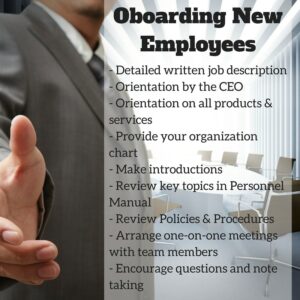It takes a lot of time and money to hire a new employee. It’s more than just paying their salary – it’s the  labor and cost of recruiting, training, and onboarding them into the work environment. This is why employee retention is so important for any business. Not only does high turnover cost you more money, it diminishes the overall workplace environment. Who wants to work in a place with constant turnover?
labor and cost of recruiting, training, and onboarding them into the work environment. This is why employee retention is so important for any business. Not only does high turnover cost you more money, it diminishes the overall workplace environment. Who wants to work in a place with constant turnover?
One thing that can greatly reduce employee turnover is a structured and welcoming onboarding process. Think about your first day of work at a new place. Were you given a tour, introduced to key employees and guided through policies and procedures? Or were you just handed a manual to read? Think of the impact it could have as a new employee if you are welcomed with open arms and given exceptional training and direction that made you feel valued. As an employee, wouldn’t that just make you more loyal and excited to work for a company that truly cares about their employees?
Here are a few ways to impact the onboarding process of a new employee and reduce turnover.
Provide a detailed written job description
Set expectations upfront by having a written, detailed job description for the employee. This description should be included in all job postings and should be reviewed in both the interview and on your new hire’s first day. People like to know what’s expected of them so setting expectations early on will have a big impact.
Provide orientation by the CEO
Have your CEO convey the company’s evolution, vision, mission and strategic plan during orientation. This will have a much bigger impact than having a manager or employee do it. As a CEO, you set the tone of the work environment. It’s important that every new hire sees your passion for the company, its mission, and its clients.
Provide orientation on the company’s products and services
Dive into all of the products and services your firm offers and the needs they fulfill for your customers. You should also walk employees through the company website so that they know where to look for answers. Every employee should have a deep knowledge of the products and services you offer.
Provide the company’s organization chart
It’s important for employees to know how your organization is structured. Who do they answer to? Who is responsible for what? Give a brief description of each team member’s key duties and responsibilities.
Introductions are important
Make sure you take your new employees around the office to make personal introductions to each team member with whom the new associate will interact. This way your new hire can easily put names with faces and reporting to them for the first time will not be awkward.
Review all key topics covered by your Personnel Manual
Here’s the thing: personnel manuals are important but no one really wants to read them. It’s much more impactful to go through the key topics in your personnel manual so that your new hire has an overview of what’s expected and can ask questions right away.
Review the company’s Policies and Procedures Manual
There may be things that are unclear or questions that your new employee might have that would not come up if you just gave them the manual to read. Reviewing your policies and procedures is a great way to set expectations and allows you to explain the why behind everything you do.
Arrange one-on-one meetings with team members
If there are certain team members your new associate will be working with, arrange one-on-one meetings so that your new associates can get to know each one of their team members.
Encourage new associates to take notes and ask questions
Lastly, encourage new associates to take notes so that they don’t feel as though they have to cram a ton of information in on the first week. Always ask if they have questions and institute an open door policy so that they feel as though they can come to you with questions, comments and concerns.
How do you onboard new associates? We’d love to hear your tips.
More Great Reads
How To Motivate and Retain Employees
Don’t Operate Your Tax Business Without These Essentials Tools
